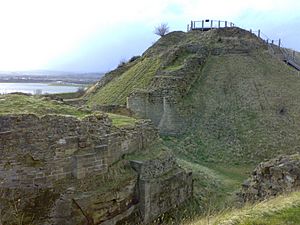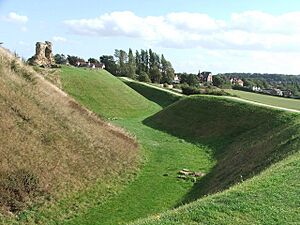Sandal Castle facts for kids
Quick facts for kids Sandal Castle |
|
|---|---|
| Sandal Magna, Wakefield, West Yorkshire | |

A view of the Motte and Barbican at Sandal Castle
|
|
| Coordinates | 53°39′32″N 1°29′28″W / 53.658889°N 1.491111°W |
| Site information | |
| Owner | Wakefield Metropolitan District Council |
| Condition | Substantial motte and ruined stonework |
| Site history | |
| Materials | Sandstone |
Sandal Castle is an old, ruined castle in Sandal Magna, a part of Wakefield in West Yorkshire, England. It sits high up, looking over the River Calder. This castle was once a very important place for kings and queens. It even appears in a play by William Shakespeare!
Contents
History of Sandal Castle: From Wood to Stone
The Warenne Family: Early Owners
The story of Sandal Castle begins with the Warenne family. In 1107, a man named William de Warenne, 2nd Earl of Surrey was given the land where the castle now stands. He built the very first Sandal Castle, which was made of wood.
Later, another family member, Hamelin, started to make the castle stronger. He began replacing the wooden parts with stone. This was a big change, making the castle much more secure.
The Warenne family owned many castles across England. These included Lewes Castle and Conisbrough Castle. They were powerful and important people in medieval England.
The Dukes of York: A Royal Connection
In 1347, the castle was given to Edmund of Langley, 1st Duke of York, who was the fifth son of King Edward III. For many years, the Dukes of York didn't spend much time at Sandal. They had other homes, like Fotheringhay Castle.
However, this changed when Richard Plantagenet, 3rd Duke of York became the owner. He was a very important figure during a time of civil war in England.
The Battle of Wakefield: A Tragic Day
In 1460, England was in the middle of the Wars of the Roses. This was a fight between two powerful families, the Yorks (who owned Sandal Castle) and the Lancastrians, for control of the throne.
Richard Plantagenet, the Duke of York, wanted to become king. In December 1460, he came to Sandal Castle with his army. On December 30, a big battle took place just outside the castle walls. This was the Battle of Wakefield.
Richard's army was much smaller than the army of Queen Margaret, who led the Lancastrians. Richard and his young son were both killed in this battle. It was a huge defeat for the York family. However, Richard's eldest son, Edward, became king just two months later.
Richard III: The Last Royal Visitor
The last king to have a strong connection to Sandal Castle was Richard III. He was Richard Plantagenet's eighth son. In 1483, King Richard III decided to make Sandal Castle an important base in the north of England. He spent a lot of money to improve it.
But his plans didn't last long. Richard III was killed in the Battle of Bosworth Field in 1485. After his death, Sandal Castle slowly fell into disrepair. It was no longer a royal home or a strong fortress.
The English Civil War: Final Battle
Even though it was already falling apart, Sandal Castle played a small role in the English Civil War in the 1640s. The castle supported the King (the Royalists) against the Parliamentarian army.
In 1645, the castle was attacked several times. Finally, the Royalist soldiers inside surrendered. After this, Parliament ordered that the castle be made unusable. This meant it could never be used as a fortress again. By then, it was already a ruin.
Exploring the Castle's Design
Castles built by William the Conqueror's followers were designed to be strongholds. They helped control towns, river crossings, and important routes. Sandal Castle was built on a natural sandstone ridge, making it a good defensive spot.
The first castles, including Sandal, were "motte-and-bailey" castles. This means they had a large mound (the motte) with a wooden tower on top. Around the mound was a courtyard (the bailey) protected by wooden fences and deep ditches.
At Sandal, the motte was made taller, reaching about 10 meters (33 feet) high. A deep moat, about 7 meters (23 feet) deep, surrounded it. Over time, the wooden parts of Sandal Castle were replaced with strong stone. This happened in the 13th century.
The stone tower, called the keep, was round. It had four smaller towers, each four stories tall. Two of these towers formed a gatehouse. One tower even had a deep well, going down 37 meters (121 feet)!
Inside the keep, there were guardrooms, storage areas, and rooms for servants on the ground floor. The main hall was above, and private rooms were on the second floor. The tower rooms even had special toilets called "garderobes," which emptied outside the castle walls.
A strong stone wall, called a curtain wall, surrounded the castle. It was about 6 meters (20 feet) high and had a walkway on top for guards. This wall protected the main courtyard, or bailey.
The castle also had a "barbican." This was an extra tower inside the courtyard, adding another layer of defense. If attackers got past the main gate, they still had to get through the barbican to reach the keep. It had its own gate and a heavy metal gate called a portcullis.
The bailey was a crescent shape, about 71 meters (233 feet) long and 52 meters (171 feet) wide. It also had a well and other facilities.
The Castle Today: Ruins and Discoveries
Over the years, the ruined castle became a source of stone for local buildings. It also became a peaceful place for people to visit and relax.
Archaeologists have studied the castle ruins. The first excavations were in 1893. A much bigger project started in 1964 and lasted for nine years. During this work, archaeologists found signs that people lived here even thousands of years ago, around 5,000 BC!
Today, Sandal Castle is a "Scheduled Monument." This means it's a very important historic site and is protected by law. It's also a Grade II* listed building, showing its special historical value.
Visitors can explore the ruins and imagine what life was like there centuries ago. Sometimes, there are special events that bring the castle's history to life, like re-enactments of the Battle of Wakefield.
Images for kids
See also
 In Spanish: Castillo de Sandal para niños
In Spanish: Castillo de Sandal para niños







